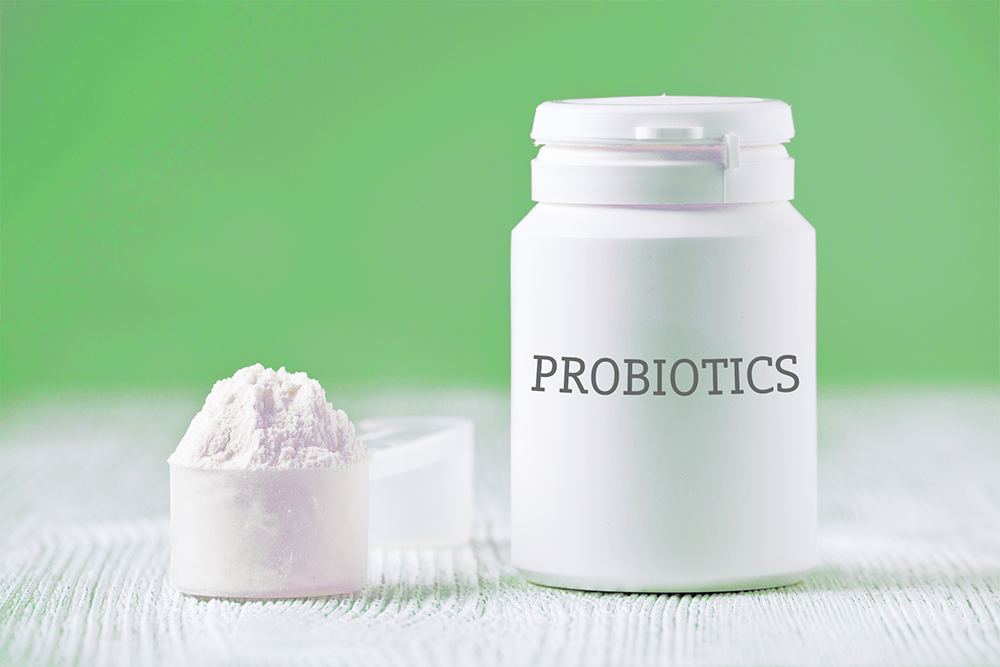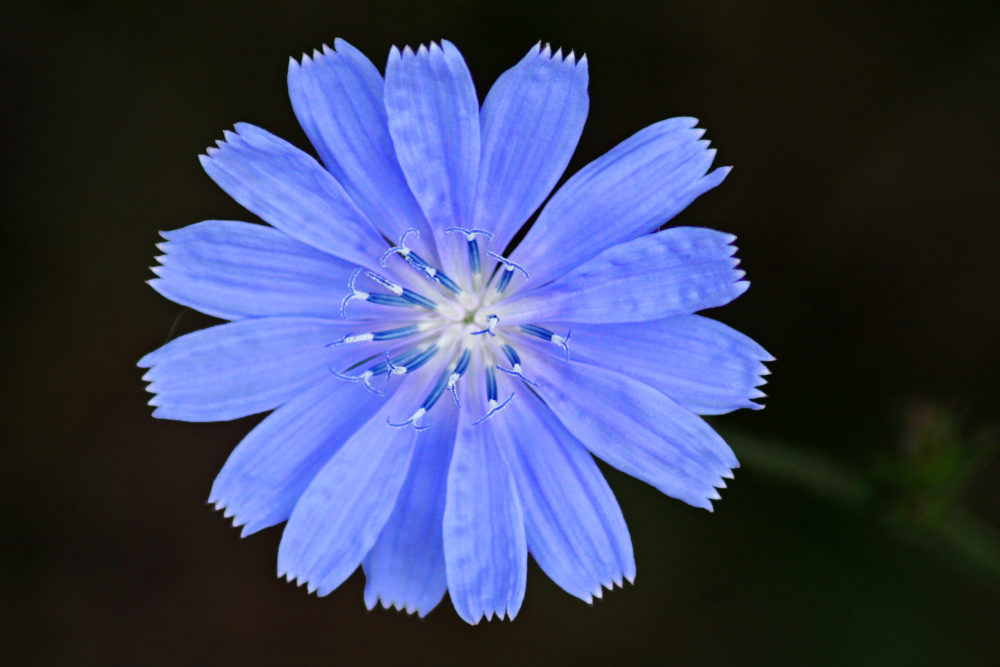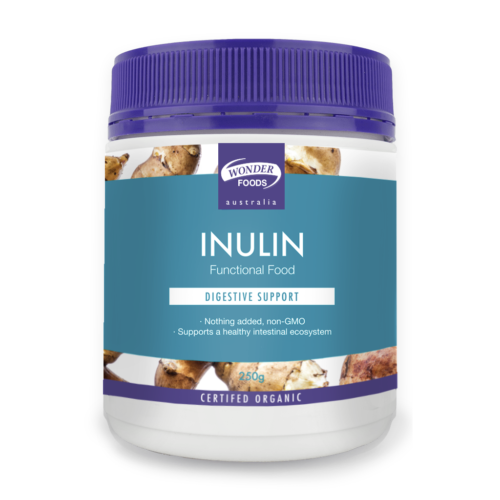According to Hippocrates, our health starts in our gut. And while our gut may be the centre of our immune system, it’s often the first thing and perhaps the easiest that we neglect. Sometimes we through a couple extra yoghurts into the grocery cart to give our digestive system an extra boost but more of often than not, that’s where we stop. Well, forget about those yoghurts, there’s a natural ingredient that is perhaps more beneficial than the occasional yoghurt for your gut. It’s white powder of immense power: here’s inulin! Wait, what is Inulin used for and what is it?
What is inulin?
Inulin is, according to academic sources: (1)
a water-soluble storage polysaccharide and belongs to a group of non-digestible carbohydrates called fructans
Exactly. Wait…what is inulin? Inulin certainly isn’t as easy to explain as a herb, plant or spice. Inulin is a carbohydrate which occurs naturally in various types of plants, usually in their roots and tubers. It’s soluble in water, un-digestible until it reaches the large intestine and very beneficial for the health of the gut. Inulin not only has an important digestive and dietary function but an immune function as well. It’s a prebiotic and that’s where most of its beneficial power comes from.

Prebiotics vs. Probiotics
The core of our immune system is located in the gastrointestinal system of our body. The strength of our immune system greatly depends on the balance of the bacteria in the gut flora, aka the microbiota. When the balance is just right, our immune system is strong, we are healthy and feel good. Whenever this balance crumbles due to bad eating habits, stress or even antibiotic abuse, our immune system can be weakened. A weak immune system means that we are more prone to illnesses and allergies. Therefore, if we want to boost our immune system, we need to take better care of our gut. This is where the probiotics and prebiotics come into play.
The word probiotic actually derives from Greek and it means pro-life, as opposed to antibiotics which literally means life-killing. Probiotics have become more popular in recent years through TV commercials about yoghurts and other dairy-based drinks. Probiotics are the good bacteria that positively benefit our health, but only if we consume them regularly enough so that they’re able to colonize our gut and secure it. They filter and eliminate harmful stuff from our bodies such as toxins, chemicals, and other waste. Yet at the same time probiotics absorb nutrients and components that our bodies require.
Prebiotics are basically food for our probiotics and help them boost and maintain the levels of the good intestinal bacteria, such as lactobacilli and bifidobacteria (2). There’s quite a lot of these guys; if we actually weigh this positive bacteria in our bodies, they would supposedly make up to 1 whole kilo, and that’s a lot of bacteria if you think about it.
Only with a proper balance of the two, can we maintain our gut microbiota healthy and working and at the same time build up a strong immune system and a good environment that keeps various diseases and illnesses at bay.
What is Inulin used for?
Inulin, as a prebiotic, is very beneficial for our intestinal flora. By consuming inulin, you consume the strains that help balance the flora in your body. These strains are also present in yoghurt, but their numbers are not as high. That is unless you’d eat a ton of yoghurt daily. That’s why many people prefer inulin supplements as it’s easier and more convenient than consuming a lot of yoghurts – plus you’re not getting that extra stuff that can be added in such as flavourings.
Inulin intake can boost probiotic production and therefore can strengthen the intestinal wall. When the wall gets weak, it can get leaky. This means that various toxins can go from inside of your gut into the bloodstream, causing various reactions. Stress, poor nutrition, alcohol and antibiotic abuse are among some of the causes of a weak intestinal wall. You can restore the health of the walls and the intestine system by eliminating bad habits, improving nutrition and positive bacteria intake. A healthy gut means fewer toxins getting to places where they don’t belong.
The strength of intestinal wall can also, consequently influence the absorption of calcium and magnesium in your body; the leakier the wall, the lower the absorption (5).

The ancient history of inulin use
It was only in the 19th century that the German scientist Valentin Rose discovered inulin as a substance. Long before this discovery, ancient and not-so-ancient tribes and civilisations have used different plants with high inulin concentration to treat various intestinal problems, such as infections, diseases, and diarrhoea. The consumption of chicory was praised by a physician of the Roman army. He spoke of its benefits on the stomach, liver, and kidneys long before people would know where its true benefits actually lie (4).
Plants that contain inulin, such as yacon and Jerusalem artichoke, were a bit hit in Europe, after they were brought over from the New World, but were forgotten with the growing popularity of potatoes. They were considered mere starch substitutes, until the beginning of the 20th century, when the first studies of inulin effects on humans were conducted. That was a crucial point that led to further investigation.
Where does inulin come from?
Inulin comes from plants and is made into a powder through a careful process. If produced commercially, chicory is the most common source from which inulin is obtained. There are, however, many other natural sources of inulin:
- Yacon (Smallanthus sonchifolius): Also known as Peruvian ground apple is something that looks like a mixture of a sweet potato and a pear. Native to South America, it’s been used widely through the Andes in the pre-Colombian civilizations already, since this plant is a good source of minerals, vitamins, and inulin. A recent study confirmed that consuming yacon improved the intestinal microbiota. (3)
- Jerusalem artichoke (Helianthus tuberosus): Known also as either the sunroot, earth apple or topinambour, this isn’t really an artichoke but it actually belongs to the daisy family. Similar to yacon, Native Americans cultivated it before the Europeans set foot in the Americas. Topinambour is native to North America, and it’s another major commercial source of inulin.
- Globe artichoke (Cynara scolymus L.): The use of artichoke dates back to Ancient Greece and Roman times. This type of artichoke is not related to Jerusalem artichoke since it’s actually a thistle. Known also as the French artichoke or globe artichoke, it’s most likely native to Mediterranean basin. Back in the 16th-century women were not allowed to eat artichokes because they were considered an aphrodisiac. Before and after that, however, the globe artichoke has been considered as a digestive aid and a natural remedy for improving liver function. Nowadays this type of artichoke has become a source of inulin production. At Wonderfoods, we use the globe artichoke for our certified organic Inulin.
- Root of dandelion (Taraxacum officinale): Native to North America and Eurasia, dandelion is a very, very old plant. It’s been used by ancient and less ancient civilisations as food and a natural remedy for infections, liver problems and used as a diuretic. Almost the whole plant is edible and quite popular with some cultures worldwide.
- Chicory root (Cichorium intybus): Chicory can be either a coffee substitute, an addition to salads or as a good source of inulin. Native to Europe, it is quite common around the world as well, such as North America, Australia, and China. Chicory goes by other names such as blue daisy, coffeeweed, wild endive or blue dandelion. It’s one of the earliest recorded sources of Inulin in literature.
- Garlic
- Leeks
- Onions
- Rice (contains less than 1% of inulin)
- Bananas (contain less than 1% of inulin)

How is inulin made?
The extraction process from plants, such as globe artichoke is similar to that of the sugar beet: (7)
- Harvest of globe artichoke
- Washing and slicing
- Extraction and purification process (inulin and other components are dissolved in water)
- Refining (removing bitter parts and colour from the liquid)
- With evaporation, inulin is concentrated
- Spray drying process serves to make powder from a concentrated inulin liquid
- The final result: inulin powder
How to consume inulin?
Now that we’ve answered the question of what is inulin, you can add it to your daily menu. It’s fairly simple to include inulin into your diet and there are two ways of doing it;
- Eat vegetables that contain high levels of inulin (such as Jerusalem artichoke or chicory)
- Use an inulin supplement. Once you know the proper dosage, you can easily add it to coffee, tea or other cold or hot drinks. It makes a good addition to your daily smoothie as well. Some people even substitute inulin powder for flour when cooking or baking.
A word of caution: Use inulin supplement with caution, as it may cause side effects if overused, such as stomach problems, gas, bloating or cramps. These problems should, however, disappear after a while with a continuous use.
- https://www.ncbi.nlm.nih.gov/pubmed/27178951
- https://www.sciencedirect.com/science/article/pii/S0271531707000358
- https://www.ncbi.nlm.nih.gov/pmc/articles/PMC4963912/
- https://books.google.si/books?id=H-O4inzaxs8C&pg=PA39&lpg=PA39&dq=who+discovered+inulin&source=bl&ots=H-Sfk_cBvF&sig=FHg8DwfLuJLlIu_ijiGd5MF3DkU&hl=en&sa=X&ved=0ahUKEwj6_sXur_DXAhWDfRoKHYP9AE4Q6AEIXTAL#v=onepage&q=who%20discovered%20inulin&f=false
- https://www.ncbi.nlm.nih.gov/pubmed/12514257
- https://www.ncbi.nlm.nih.gov/pmc/articles/PMC3705355/ (prebiotics vs probitics)
- http://pubs.acs.org/doi/pdf/10.1021/ja01453a020



